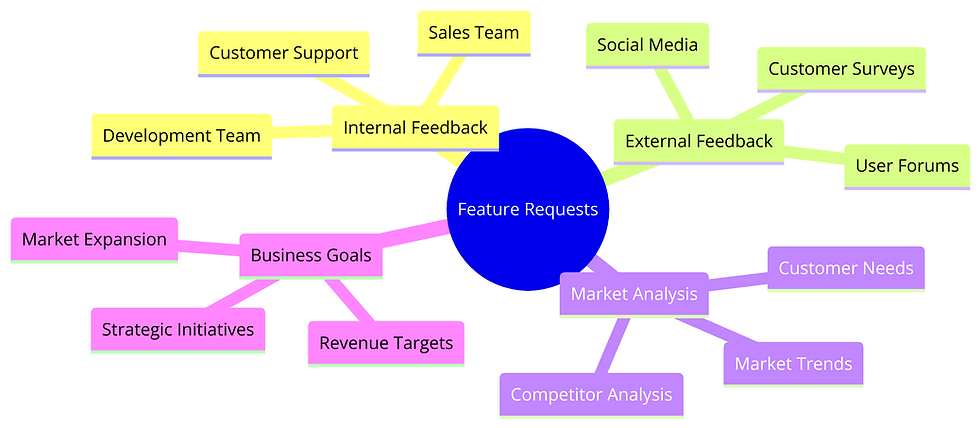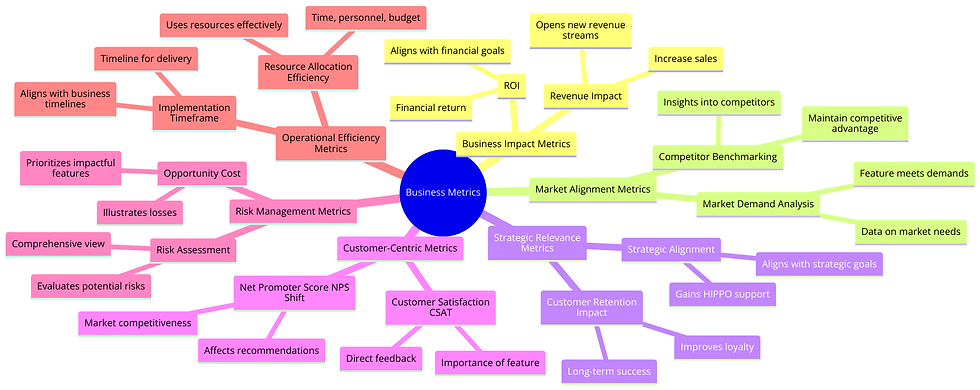
Introduction
I am writing this article to highlight the benefits and challenges that come with the life of a PM. As a product manager (PM), feature requests are a constant companion, and while valuable insights are crucial for product improvement, an unmanaged influx can quickly turn into a full-blown nightmare.
Have you ever woken up to a seemingly endless inbox overflowing with feedback or feature requests?
The journey from an overwhelming wish list to a coherent and strategic product roadmap is fraught with challenges, requiring a delicate balance between innovation, practicality, and stakeholder alignment. In the life of a product manager, these feature requests can range from minor tweaks inspired by user feedback to groundbreaking functionalities that promise to redefine the product's market standing. This article highlights the common challenges PMs face with feature requests, explores what users truly desire, and equips you with effective strategies to navigate the chaos, including navigating the influence of HIPPO stakeholders.
Where Do New Feature Requests Come From?

In the mind map above, you will find that Feature Requests emerge from multiple channels, divided into broad categories: Internal Feedback, External Feedback, Market Analysis, and Business Goals.
Stakeholders of the Feature Requests
When it comes to new features and requests, stakeholders from various corners of the product development ecosystem can be valuable sources of inspiration. Here's a breakdown of key stakeholders and the kind of feature ideas they might contribute:
Customer-Centric Stakeholders:
End Users: These are the lifeblood of your product. Their needs and frustrations should be the primary drivers of feature requests. Utilize various channels to gather user input:
Customer Support Teams: They deal with user issues daily and can identify recurring pain points that translate into feature requests.
Sales and Marketing Teams: They interact with potential and existing customers, gauging their needs and feature requests.
Data-Driven Stakeholders:
Product Analysts: They analyze product usage data and can identify areas where features could improve user experience or address underutilized functionalities.
Data Scientists: They can leverage advanced analytics to uncover hidden trends and patterns in user behaviour, potentially suggesting new features to address them.
Internal Stakeholders:
Product Team: This includes product managers, designers, and developers. They collaborate to brainstorm new features based on user research, technical feasibility, and product vision.
Customer Success Team: They interact closely with users and gain insights into their challenges and feature requests.
Sales Engineers: They understand customer needs during the sales process and can suggest features that would improve product adoption or address specific client requirements.
Executive Stakeholders:
CEO/CTO: They can provide a high-level vision for the product and suggest features that align with the company's overall strategy or emerging technologies.
VP of Product/Marketing: They have a broader perspective of the market and may suggest features based on industry trends or competitor analysis.
It's important to note that not all stakeholders have the same weight in feature prioritization. User needs should always be a top priority. However, considering feedback from various stakeholders helps create a well-rounded roadmap that balances user experience, business goals, and technical feasibility.
Challenges of the Feature Requests: A Product Manager's Minefield

Feature requests are a double-edged sword for product managers (PMs). While valuable user feedback is essential for product improvement, an unmanaged influx can quickly turn into a chaotic nightmare. Here's a breakdown of the key challenges PMs face when navigating the feature request minefield:
Prioritization Puzzle:
Imagine a never-ending stream of requests, each seemingly important. User A wants a fancy new design, while User B craves a core functionality upgrade. Both sound valid, but resources are finite. How do you choose which feature to tackle first? This prioritization puzzle can be a constant struggle for PMs, requiring careful consideration of user impact, development effort, and alignment with the product vision.
Feasibility Abyss:
A user suggests a revolutionary feature, but it would require a complete overhaul of your product's architecture. It might be a game-changer, but is it worth the investment of time and resources? The feasibility abyss forces PMs to weigh the potential benefits of a complex feature against the risks and disruptions associated with development.
The Communication Maze:
Keeping users informed about the status of their requests can feel like a never-ending loop. Striking a balance between acknowledging every request and providing detailed explanations can be time-consuming. How do you manage expectations without getting bogged down in endless explanations? Effective communication is crucial, but it can be a major challenge for PMs with a large volume of feature requests.
The HIPPO Effect:
HIPPO (Highest-Paid Person's Opinion) stakeholders like CEOs or VPs can add another layer of complexity. Their feature requests, driven by high-level vision or business goals, might contradict user needs or technical limitations. PMs need to navigate these requests with diplomacy, presenting data-driven insights and alternative solutions to ensure the final product roadmap reflects a balance of user needs, business objectives, and executive vision.
Scope Creep:
Feature requests often spark additional ideas and modifications. While some refinements can be valuable, uncontrolled scope creep can significantly expand the project and delay development timelines. PMs need to manage expectations and maintain a clear vision to prevent feature creep from derailing the roadmap.
Unrealistic Expectations:
Users might not understand the complexities of development. Their feature requests may have unrealistic timelines or underestimate the resources required. PMs need to communicate development realities and manage expectations to avoid user frustration after feature releases.
These are just some of the challenges PMs face when dealing with feature requests. By understanding these obstacles and developing effective strategies to address them, PMs can transform feature requests from a source of stress into a valuable tool for product improvement.
Sources of the Feature Request
As a product manager (PM), your job is to constantly innovate and improve your product. But where do all those feature requests come from? Here's a roadmap to explore various sources of new features and user requests:

Customer-Centric Sources:
User Feedback: This is the gold mine of feature requests. Utilize various channels to gather user input:
Customer Support Tickets: Analyze recurring issues and pain points mentioned in support requests.
Online Reviews: Read user reviews on app stores or product review websites to identify areas for improvement.
Social Media: Monitor social media conversations to see what users are saying about your product and what features they're requesting.
User Surveys and Interviews: Conduct targeted surveys or user interviews to get a deeper understanding of user needs and frustrations.
Feature Request Boards: Implement a system where users can directly submit feature suggestions and vote on existing ones.
Data-Driven Insights:
Product Analytics: Dive deep into your product analytics to identify areas where users struggle or features are underutilized. This can reveal opportunities for improvement or entirely new functionalities.
A/B Testing: Conduct A/B tests to experiment with different features and user interfaces. Analyze the results to see what resonates with users and what needs tweaking.
User Session Recordings: Observe how users interact with your product through session recordings. This can reveal hidden pain points and areas where a new feature could streamline the user experience.
Competitive Analysis:
Market Research: Keep an eye on your competitors and emerging trends in your industry. Analyze what features your competitors offer and identify potential gaps you can address.
Industry Reviews and Publications: Read industry publications and reviews to stay up-to-date on the latest technologies and user needs within your domain.
Internal Brainstorming:
Team Collaboration: Organize brainstorming sessions with your product team, developers, and designers. Encourage out-of-the-box thinking and explore various feature ideas.
Customer Success Team: Collaborate with your customer success team. They often have a front-line view of user needs and common challenges.
Additional Inspiration:
Industry Events and Conferences: Attend industry events and conferences to network with other professionals and learn about emerging trends in your field.
Technology Blogs and Publications: Stay informed about new technologies that could potentially enhance your product's functionality.
Remember: Don't just chase every shiny feature! Prioritize requests based on a combination of user demand, alignment with your product vision, and feasibility of development. By effectively collecting and evaluating ideas from these diverse sources, you'll have a constant stream of inspiration to keep your product evolving and meeting user needs.
What I used to do and prefer to do NOW also:
You have been through these scenarios where you get challenge in doing feature identification and pritoritztion coz each stakeholder has its own biases / needs / metrics to fulfil in the game. When I had encountered these scenarios, I used to perform prioritisation challenge with the stakeholders based on the metrics those are aligned towards Business Impacts, Market Alignment, Customer Centric, Strategic relevance, Risk Management and Compliance.

Ask stakeholders about Business Impacts, Market Alignment, Customer Centric, Strategic relevance, Risk Management and Compliance.
Business Impact Metrics
ROI (Return on Investment): Demonstrates the potential financial return from implementing a feature, aligning decision-making with the company's financial goals.
Revenue Impact: Provides estimates on how a new feature could potentially increase sales or open new revenue streams, which is persuasive for profit-oriented decision-makers.
Market Alignment Metrics
Market Demand Analysis: Shows data on market needs and how a feature meets these demands, reinforcing its market-driven justification.
Competitor Benchmarking: Offers insights into what competitors are doing, helping to position the feature as a necessary response to maintain or gain competitive advantage.
Strategic Relevance Metrics
Strategic Alignment: Evaluates how well a feature aligns with the organization's strategic goals or addresses key initiatives, which is crucial for gaining HIPPO support.
Customer Retention Impact: Indicates how a feature might improve customer loyalty and retention, which is directly linked to long-term business success.
Customer-Centric Metrics
Customer Satisfaction (CSAT): Reflects direct feedback from users, highlighting the importance of a feature from the customer's perspective.
Net Promoter Score (NPS) Shift: Predicts how a new feature could affect the likelihood of recommendations, an important indicator of customer perception and market competitiveness.
Risk Management Metrics
Risk Assessment: Evaluates potential risks associated with not implementing a feature, including technical, market, or operational risks, providing a comprehensive view of the implications.
Opportunity Cost: Illustrates what might be lost if a feature is not implemented, helping to prioritize features with the most significant positive impact.
Operational Efficiency Metrics
Implementation Timeframe: Provides a clear timeline for feature delivery, ensuring that expectations are realistic and aligned with business timelines.
Resource Allocation Efficiency: Demonstrates how effectively the feature uses organizational resources, including time, personnel, and budget.
Taming the Feature Request Beast: A PM's Survival Guide with HIPPO Considerations
Now that we've explored the challenges and user expectations, let's equip you with the tools to conquer feature request nightmares, while also navigating the influence of HIPPO stakeholders:
Centralized Collection: Consolidate all feature requests into a single system for easy organization, prioritization, and future reference. Collaboration tools or project management software can be a great fit.
Prioritization Framework: Establish a clear system for evaluating requests. Consider factors like user impact, development effort required, and alignment with your product goals. Don't shy away from including data-driven insights to support your decisions, especially when faced with a strong HIPPO opinion.
Communication is Key: Respond promptly to requests, even if it's just to acknowledge receipt. Provide regular updates and explain the reasoning behind decisions. When communicating with HIPPO stakeholders, tailor your message to their level of technical understanding and focus on the bigger picture benefits.
The Power of "No" (But Do It Kindly): Not all requests can be implemented. Learn to politely decline while offering alternative solutions or explaining the rationale behind your decision. For HIPPO pushback, be prepared to present alternative solutions or data that contradicts their suggestion. Frame the conversation as a collaborative effort to find the best solution for the product.
Transparency Through a Centralized Roadmap (Optional): A centralized roadmap can set expectations and give users (and HIPPO stakeholders) a high-level view of upcoming features.
Conclusion: From Chaos to Clarity
Feature requests is a double-edged sword. By implementing these strategies, you can transform this chaos into a valuable source of product improvement. Remember, effective management keeps users engaged, fosters trust, and ultimately paves the way.
About the Author

Anubhav Sinha stands at the forefront of product innovation and education, co-founding the esteemed Product Capability Uplift (PCU). In his pivotal role at PCU, Anubhav spearheads the development of cutting-edge programs, AI capabilities and courses, relentlessly driving the growth and capability-building initiatives of the Product Academy. His unique approach as a Product Thinker has significantly shaped the academy’s direction and impact.
A Post-Graduate learner in Marketing -IB and with over 15+ years of rich practising experience in product management and development, Anubhav is a recognised community builder in the field. His expertise spans across both B2B and B2IB product landscapes, where he has made substantial contributions, particularly in the start-up ecosystem. Renowned for his role in nurturing start-ups during their formative stages, Anubhav has also made his mark in established industry product organizations as a user-experience flow optimizer.
Throughout his career, Anubhav has donned multiple hats - from a Product Owner to a Principal Product Owner to a Co-founder to a Product and Design Thinking Coach to a Principal Product Manager. His transformative coaching style and profound knowledge of product ownership have made him a sought-after figure in the tech product realm.
A product coach and an avid technology product enthusiast, Anubhav's contributions and insights are not just limited to his immediate professional engagements. His passion for the field resonates through the valuable content he creates and the mentorship he offers, continually inspiring and guiding the next generation of product management professionals.

Comments